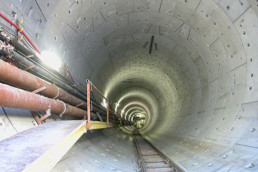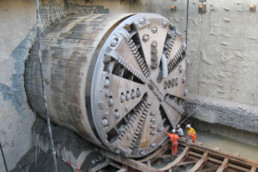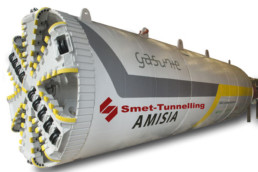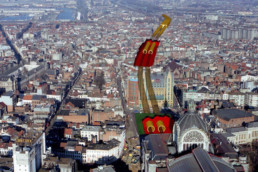Tunnel Borings with Tubings
Tunnel borings with hydro shield or mix shield (TBM), whereby the tunnel wall is constructed with tubings for diameters from 3 metres. The tunnel wall is built directly behind the TBM in rings using tubings. After the construction of each ring, the TBM will once again push against the last ring built to continue boring. The technique is applicable for cable ducts, underground storage tunnels, metro and railway tunnels.
References
DIABOLO (Zaventem)
Principal: Infrabel
Main Contractor: THV Dialink between CEI-De Meyer – MBG – Wayss&Freytag – Vinci Construction – Smet-Tunnelling
Execution: April, 2009 -October, 2009
Machine: TBM
Tubings:
ID-OD: 7,300 – 8,000 mm
Length: 2 x 1,070 m
The Diabolo project will turn Brussels National Airport into a major hub of the Belgian and international railway network with 2 bored tunnels of 1,070 m each under the runways. The geological context is quite favourable (sand and soft sandstone).
EMDEN
Principal: Gasunie
Main Contractor: BAM-Combinatie Eemstunnel (BCE), joint venture between BAM-Civiel (NL) and Wayss&Freytag (D)
Execution: March-December, 2009
Machine: TBM
Tubings: 6 per ring each measuring 1.2m in width
ID-OD: 3,000 – 3,500 mm
Length: 4,016 m
Boring of a tunnel measuring 4,016 metres in length, with an internal diameter of 3 metres. Afterwards, a coated steel gas pipe with a diameter of 48 inch (about 1.22 metres) is placed in this tunnel. The gas pipe in the tunnel, with an internal pressure of about 80 bar, is part of a new North-South gas line constructed by Gasunie.
ANTWERPEN (ASDAM)
Principal: NMBS – TUCRail
Main Contractor: TV Asdam tss. CFE-MBG – CEI Construct – Dumez-GTM – Jan De Nul – Van Laere – Wayss&Freytag and Smet-Tunnelling
Execution: 2002-2003
Machine: TBM
Tubings: 7 tubings + 1 keystone
ID-OD: 7,300 – 8,000 mm
Length: 2 x 1,200 m
The rail section is situated underneath a densely built and populated old part of town. Owing to the longitudinal section of the tracks, we had to bore underneath the block of houses Viséstraat – Sint-Jobstraat, whilst maintaining a very short distance between the tunnels and the foundations of the houses. To ensure safe tunnel boring, a pipe roof was installed under the houses first.






